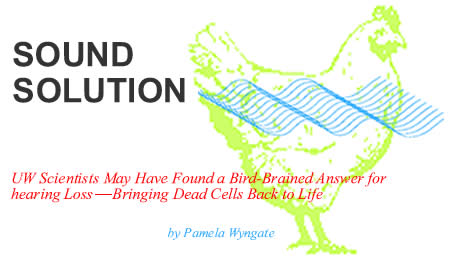
In the mid-1980s two and two were not equaling four in Ed Rubel's lab.
Rubel, a UW professor who was conducting research on hearing loss, could not understand why Raul Cruz, a surgery resident working with him, kept coming up with results that made no sense.
Rubel was a new arrival from the University of Virginia, where he'd conducted hearing loss research for years. He told Cruz to add up the dead cells inside the ears of chickens after giving the birds doses of antibiotics. Scientists already knew that some patients receiving therapeutic doses of certain antibiotics suffered hearing loss. Rubel wanted to know when and how that loss occurred, so he focused on chickens, which suffer the same pattern of hearing loss when exposed to the same drugs.
Yet Cruz presented Rubel with an impossible result-he counted more living cells at the end of the experiment than at the beginning.
"My first reaction was that he must have done something wrong-counted incorrectly or mixed up his animals," says Rubel. "I told him to go back to the lab and to keep his animals straight."
Cruz returned with the same data. Rubel was surprised and perplexed that the promising resident didn't seem to be getting it right.

"We all knew that there was a progressive loss of cells after this kind of treatment," says Rubel. "So we decided to use different counting criteria."
The third time Rubel saw the same data, he realized that something unexpected was happening. What he was observing contradicted everything known at the time about neurobiology and hearing.
"Somehow cells were coming back to life after they'd already been gone," he explains.
The resurrection of hair cells in the inner ear of chickens might sound esoteric to the average American-but for the 28 million people who suffer from hearing loss, it could be the beginning of a new way of life. About 80 percent have irreversible hearing loss, and the number one cause is the death of hair cells-the very cells Cruz was counting. If Rubel could find out how these cells return to life, perhaps he could apply that knowledge to humans.
He found that the secret of the regrowth was in the birds' genes. Using DNA technology, Rubel and his colleagues went on to show that, after the damage, new cells were produced by cell division. "But that was really a confirmation of what we'd been seeing all along when we were actually counting cells," he says. "I don't think that most of the world believed that birds actually produced new cells until the early 1990s. It takes a while for other people to replicate the work and realize that this wasn't just a freak of a chicken."
Rubel-whose joint appointments span three UW departments: otolaryngology-head and neck surgery, physiology and biophysics, and neurosurgery-adds, "We haven't cured anybody yet. What we've found is a potential pathway-our hair cell work has opened a new area of research in the effort to treat hearing disorders."
-
Go To: Page 1 | Page 2 | Page 3
- Sidebar: Celebrities Who Don't Hear the Applause
- Return to December 2001 Table of Contents